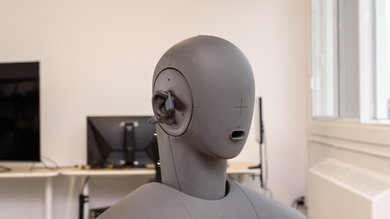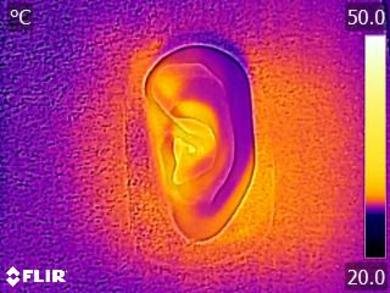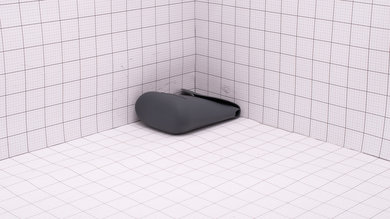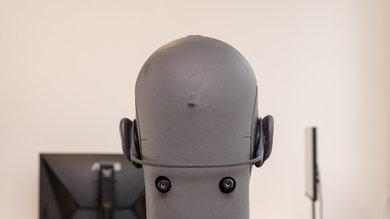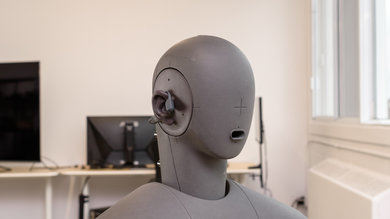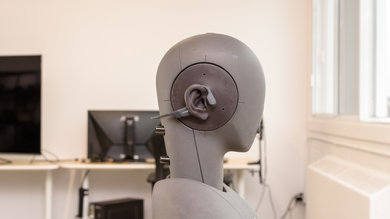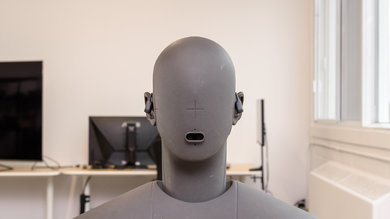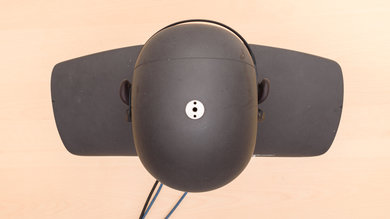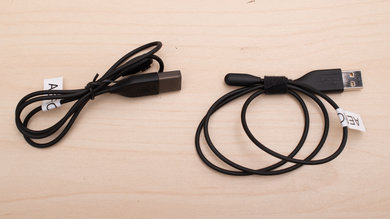The AfterShokz Aeropex Bone Conduction are Bluetooth headphones. Due to their unique design, which uses vibrations instead of speakers to produce sound, they don't go on or inside the ear in any way, and they simply rest on your temples. Due to this, they don't block any ambient noise, making them a good choice if you like to always have background music playing while still being able to carry on conversations, or if you run outdoors and want to stay aware of your surroundings. Overall, they're a unique pair of headphones that won't be for everyone, but for specific uses, they may be exactly what you're looking for.
Our Verdict
The AfterShokz Aeropex are bad for neutral sound. Since they have no speakers and produce sound via vibrations, our testing rig was unable to properly chart their frequency performance. Therefore real-world usage should likely produce better results than our scores show. That being said, they produce sound uniquely and aren't ideal for people looking for a more neutral sound.
- Comfortable and stable.
- Sound varies depending on fit and positioning.
- No app support or EQ.
The AfterShokz Aeropex are sub-par for commuting and travel. They're portable and breathable, but by design, they don't block any ambient noise. While some people may like that they allow you to stay aware of your surroundings, they leak quite a bit of sound at high volumes, which isn't ideal if you need to crank them up to hear your music over the rumble of a bus or plane engine. On the upside, they have a comfortable fit that feels like wearing a pair of glasses, which is nice during a long trip.
- 13-hour battery life.
- Leak a lot of audio at higher volumes.
- Bone conduction design doesn't block any noise.
The AfterShokz Aeropex are decent for sports and fitness. They have a comfortable and lightweight design that feels just like wearing a pair of glasses and don't put any pressure on your ear. They're stable and extremely breathable since they don't go in or cover the ear, so you won't sweat more than usual. They're particularly well-suited for outdoor workouts since their design means they don't block out any ambient sound, which helps you stay aware of your surroundings. They even have an IP67 rating for water and dust resistance, although we don't test it currently.
- Open design is good for exercising outdoors.
- Sound varies depending on fit and positioning.
The AfterShokz Aeropex are poor for office use. They don't block out any background noise and leak quite a bit of audio when you listen at a high volume, which could bother your co-workers. However, they're comfortable, and they allow you to listen to music while still paying attention to your surroundings or carrying on a conversation, which could be ideal for some jobs.
- 13-hour battery life.
- Leak a lot of audio at higher volumes.
- Bone conduction design doesn't block any noise.
The AfterShokz Aeropex are Bluetooth-only headphones. They're compatible with Bluetooth-enabled PCs, but their latency is too high to be recommended for gaming.
The AfterShokz Aeropex are Bluetooth-only headphones that can't be used wired.
The AfterShokz Aeropex are sub-par for phone calls. Their microphone performance is mediocre, as it makes your voice sound muffled and doesn't do a very good job of separating it from background noise, which makes it harder for the person on the other end to hear you. Also, since they sit outside of your ears, they don't isolate you from background noise, so it may be hard for you to hear the person you're speaking with as well.
- 13-hour battery life.
- Mediocre microphone performance.
Changelog
- Updated Apr 03, 2023: We've included a comparison to the Sony Float Run Wireless in the Stylebox.
- Updated Feb 15, 2022: We've retested 'Additional Controls' for EQ presets.
- Updated Oct 08, 2021: Converted to Test Bench 1.5.
- Updated Mar 18, 2021: Updated review for accuracy and clarity.
Check Price
Differences Between Sizes And Variants
The AfterShokz Aeropex Bone Conduction headphones are available in four different color variants: 'Cosmic Black', 'Solar Red', 'Lunar Grey', and 'Blue Eclipse'. We tested the 'Cosmic Black' variant and expect the other colors to perform similarly to our unit. These headphones are also available in another size, 'Mini', with a shorter headband. However, we haven't tested that variant, and our results are only valid for the 'Standard' size.
There's an upgraded variant of these headphones called the Shokz OpenRun Bone Conduction too. They offer a similar performance to the AfterShokz Aeropex but also support Bluetooth 5.1 and have a quick-charge feature. If you come across another variant or your headphones are different, please let us know in the discussions below so we can update our review.
Popular Headphones Comparisons
The AfterShokz Aeropex are headphones intended for sports that use bone conduction instead of speakers to produce sound. They have a comfortable and stable fit and don't block out any background noise, which is ideal for people who want to listen to music while running or cycling outside while still staying aware of their surroundings. They have a longer battery life than the similarly-designed AfterShokz Trekz Air Bone Conduction, and unlike that model, they're rated IP67 for water and dust resistance, although we don't currently test for that.
See our recommendations for the best headphones for working out, the best wireless earbuds for running, and the best Bluetooth earbuds.
The Shokz OpenRun Bone Conduction are the next generation of the AfterShokz Aeropex Bone Conduction. While both are otherwise the same in terms of build quality, comfort, and sound quality, the OpenRun have a quick charge feature, and they support Bluetooth 5.1. The Aeropex come with two charging cables instead of one, and their soft case is better than the OpenRun's drawstring pouch.
The Shokz OpenRun Pro Bone Conduction are the upgraded, next generation of the AfterShokz Aeropex Bone Conduction. While both headphones are comfortable, the OpenRun Pro have a significantly better carrying case and better overall battery performance. They also have a companion app that offers two EQ presets. However, the Aeropex have a higher IP rating.
The AfterShokz Aeropex Bone Conduction are an upgrade over the AfterShokz Trekz Air Bone Conduction. They're both bone conduction headphones, but the Aeropex have a much better control scheme, a longer battery life, and are rated IP67 for dust and water resistance. On the other hand, the Trekz Air use a standard micro-USB charging cable as opposed to the Aeropex's proprietary cable.
The Apple AirPods (2nd generation) and the AfterShokz Aeropex Bone Conduction are very differently designed headphones, which you might prefer depending on your needs. The Apple are more conventional in-ears and leak much less audio. Their truly wireless design and compact charging case make them much more portable as well. On the other hand, the AfterShokz deliver sound via bone induction and sit outside your ears. Because of their design, they don't block any ambient noise, which is great for people who exercise outdoors. They also have an IP67 rating for dust and water resistance.
Test Results

The AfterShokz Aeropex have a unique style that looks similar to other models by the manufacturer but are unlike most other headphones on the market. Unlike traditional earbuds, these headphones don't go into your ear but instead sit on top of your temples. They have a headband that goes around the back of your head and ear-hooks to help keep the headphones on your ears. You can purchase them in a few different colors, including 'Cosmic Black', 'Solar Red', 'Lunar Grey' and 'Blue Eclipse'. If you're looking for similar headphones but want a more traditional driver system, consider the Sony Float Run Wireless.
The AfterShokz Aeropex are comfortable headphones. They don't weigh very much, and you don't feel them as much as over-ear or on-ear headphones. They apply a bit of pressure where they sit above your ears, which feels similar to wearing a pair of glasses. The headband doesn't stick out as much at the back as the AfterShokz Trekz Air Bone Conduction but can still get caught on clothing like hooks and sweaters. Also, since the audio is delivered via vibrations, bass-heavy music like EDM or hip-hip may become annoying if you're listening for a long time. This shouldn't be an issue with other genres or content like audiobooks, though.
Update 02/15/2022: It was originally reported that these headphones only had voice assistant for additional controls. However, you can also cycle between two EQ presets when you hold both volume buttons for three seconds while your music is playing. As a result, the review has been updated.
The AfterShokz Aeropex's controls are okay and a big improvement over the AfterShokz Trekz Air Bone Conduction. There are two small buttons just behind your right ear for turning the headphones on and off, volume control, pairing, and checking the battery status when you're not listening to music. There's also a button on the left earbud for play/pause, track skipping, and accessing the voice assistant. When you hold both volume buttons for three seconds, you can switch between the following modes: 'Standard', which is designed for regular use, and 'Earplug', which is advertised to help improve sound quality when you're wearing earplugs. Overall, the buttons are easy to use. There are voice prompts for power on/off, battery level, and pairing, and the volume control gives audio cues.
The AfterShokz Aeropex are decently portable. They aren't that bulky, though their rigid headband means they can't be folded into a more compact format. They're portable enough to slide into a bag or larger pockets in pants or shorts but won't fit in most jean pockets. On the upside, they come with a small soft case to protect them and to help with traveling, but it does add a bit of bulk. If you're looking for more portable open-ear headphones, consider the Bose Sport Open Earbuds Truly Wireless.
These AfterShokz Aeropex come with a mediocre case. It's soft, so while it should protect against scratches, it likely won't prevent physical damage from dropping or banging the headphones. Also, unlike the Shokz OpenRun Pro Bone Conduction's hard case, this case doesn't zip shut, so it doesn't protect much against water and other liquids.
The AfterShokz Aeropex have a good build quality. They feel fairly solid and shouldn't get too damaged from a few accidental drops or bumps. They're made of a silicone material and are rated IP67 for dust and water resistance, though we don't currently test for this. Unfortunately, the headband is thin and is likely the weakest point, though it's quite flexible.
Since the AfterShokz Aeropex have no speakers and use vibration to produce sound, our testing rig can't accurately record these results. Therefore, our frequency response graph doesn't portray the actual sound as it would be perceived by your ear. Overall, the sound produced by these headphones is better suited for most vocal-centric content, like podcasts or audiobooks. However, they're likely decent for most genres of music, and provide surprisingly decent bass response, though they won't give you the same kind of thumping bass as traditional headphones. Their companion app also gives you access to an EQ, so you can tweak their sound.
The AfterShokz Aeropex have poor frequency response consistency. Due to their unique bone conductor transducer, they deliver audio very inconsistently as they're sensitive to fit and positioning. You may experience different sound profiles depending on how they're placed on your head.
The AfterShokz Aeropex's bass accuracy is bad, but it's because they're bone conduction headphones that produce sound through vibrations. Their mid and low-bass ranges are underemphasized, so mixes lack thump, rumble, and punch. However, the high-bass range is somewhat overemphasized, so instruments sound full and a bit boomy.
The AfterShokz Aeropex's mid-range accuracy is sub-par. These headphones deliver sound via bone conduction, making them difficult to accurately measure with our current testing rig. Therefore, these results likely won't match what you'd hear in real-world usage. In quiet environments, you should get a decent performance from the mid-range and be able to hear lead instruments and vocals in good detail. Unfortunately, in louder situations like on a train or bus, the mid-range tends to get lost, and you may only get the thump and rumble of low bass that is felt rather than heard, as well as some harsher and sharper treble frequencies.
The AfterShokz Aeropex's treble-range accuracy is decent. Because they deliver sound via bone conduction instead of speakers, they're difficult to accurately measure with our current testing rig. Therefore, these results may not match what you'd hear in real-world usage. Their treble range is decently well-balanced, though sibilants like S and T sounds may be sharp and piercing at high volumes.
The AfterShokz Aeropex produce sound via vibrations and don't have any speakers, so our testing rig can't properly measure their frequency response. That being said, in real-world usage, there's a peak in high-treble that causes cymbals and sibilants (S and T sounds) to sound sharp and piercing.
The AfterShokz Aeropex's imaging is poor. It's worth noting that since these headphones have no speakers and use vibration to produce sound, our testing rig can't accurately record these results. Therefore, our results here likely won't correlate to real-world situations.
The AfterShokz Aeropex have a disappointing passive soundstage. Because they sit outside your ears, it sounds open and spacious, but since they don't interact with your outer ear, sound seems to be coming from inside your head instead of from all around you. It's worth noting, however, that since these headphones produce their sound via vibrations and not speakers, our testing rig can't accurately measure them.
The AfterShokz Aeropex's measured weighted harmonic distortion is bad. It's worth noting, however, that since these headphones produce their sound via vibrations and don't have speakers, our testing rig can't accurately measure them.
These are the settings we used to test the AfterShokz Aeropex. Our results are only valid when using these settings.
The AfterShokz Aeropex are very bad at noise isolation, but it's by design. They don't go into your ears or cover them and deliver audio while still letting in ambient sound. This is great for outdoor runners, cyclists, and anyone else who wants to listen to music while staying aware of their surroundings.
Note:They come with a pair of foam earplugs intended to be worn with the headphones when you're commuting and traveling and want to block out some background noise. While we haven't tested these headphones' noise isolation capabilities when also wearing the earplugs, they should improve the headphones' isolation performance and help create an experience closer to using in-ears, which passively block some noise because they sit inside your ears.
The AfterShokz Aeropex have a disappointing leakage performance. They leak quite a bit of audio, although it depends on your usage. If you're listening at quiet enough volumes that you can still carry on a conversation with someone, they shouldn't be able to hear your music. However, if you crank up the volume, a lot of sound escapes, and it's likely to bother people around you.
These headphones' microphone has an okay recording quality. If you're on the phone with someone, they should be able to understand you, but your voice sounds muffled and lacks detail and fullness.
The AfterShokz Aeropex have a mediocre noise handling performance. If you're on the phone in a moderately noisy environment, it's hard for the person on the other end to hear you. In a loud place like a busy subway station, your voice may be drowned out entirely.
The AfterShokz Aeropex have a decent battery performance. They last for nearly 13 hours of continuous use from a single charge. This is a lot longer than the advertised battery life of eight hours, and most people should be able to go a few days without recharging them. There's also a standby mode that you can use to prevent the battery from draining when you're not using them. It should be noted that battery life can vary with real-life usage, so your experience may be different.
Unfortunately, unlike the AfterShokz Trekz Air Bone Conduction, they use a proprietary charging cable, which means you can't borrow a cable from a friend if the battery dies. Luckily, there are two cables included in the box.
The AfterShokz Aeropex have great Bluetooth connectivity. They support multi-device pairing, meaning you can connect them to both your phone and laptop at the same time instead of switching back and forth between the two, which is nice. They have fairly low latency on Android and iOS but high latency on PCs, so they aren't recommended for playing games or watching videos on your computer. That said, some apps seem to compensate for audio lag, so you may have a different experience.

